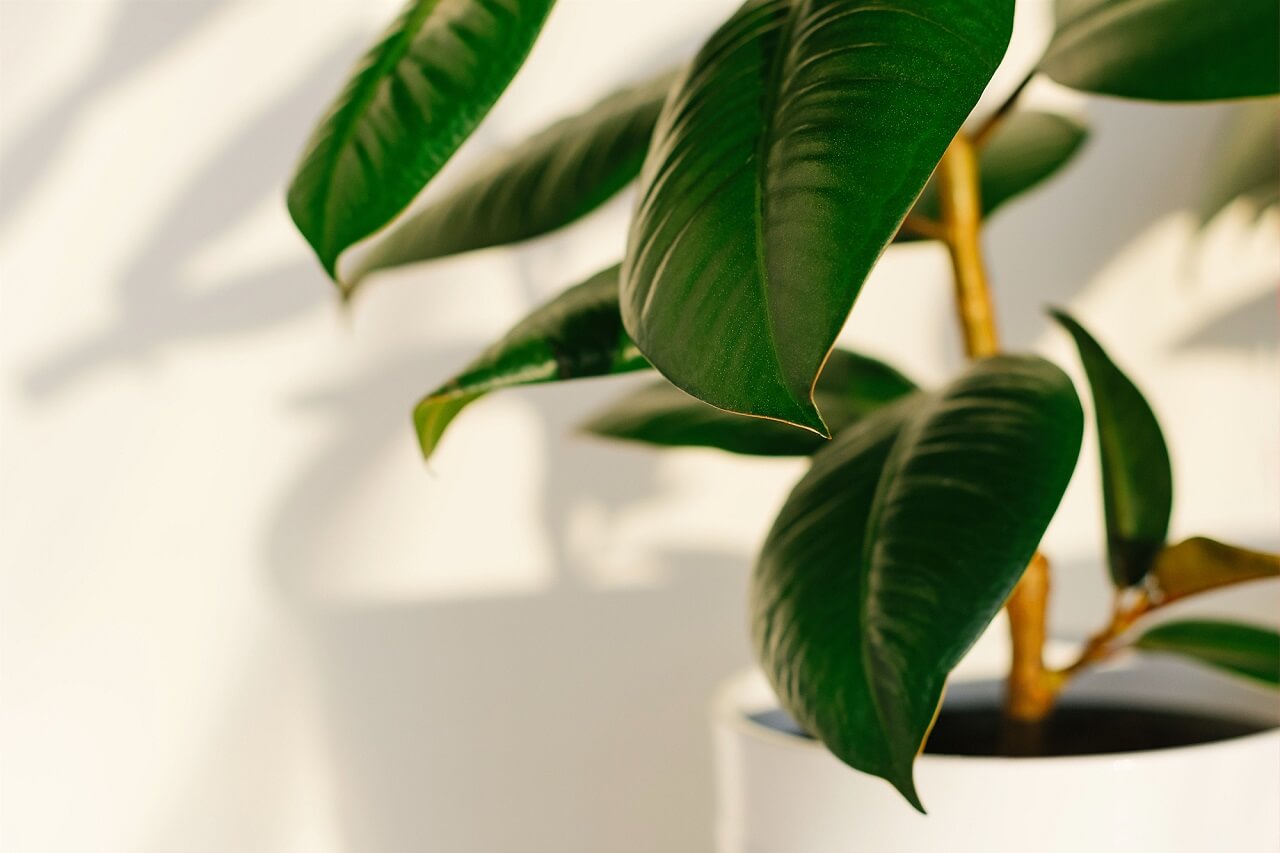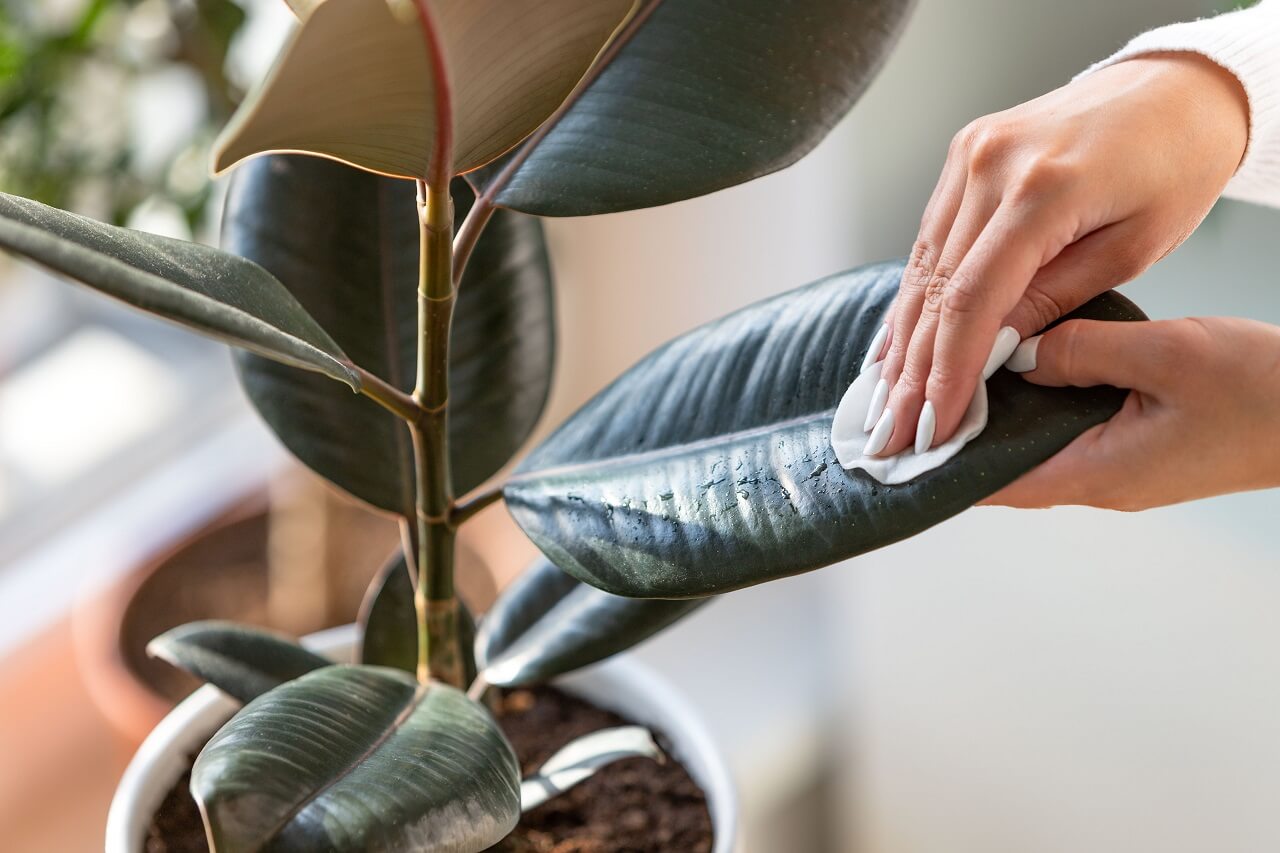Is your once beautiful Ficus elastica suddenly looking sad and lackluster? If so, we’ve all been there! Sometimes a plant that seemingly has all its needs met will protest dramatically. This can actually be a good thing since it calls attention to the issue so you can address it. In this article, we’ll help with troubleshooting your sick rubber tree and discuss how to fix it.
What You'll Learn Today
What is Wrong With My Rubber Plant?

Rubber plants are fairly hardy houseplants that can tolerate a good amount of neglect and adverse conditions. But like most houseplants, it’s not above rebelling when it really needs something.
When a rubber tree is unhappy, it may show one or several of these signs:
- Dull leaves
- Yellow or brown leaves
- Wilting or drooping
- Black spots on leaves
- Lack of growth
- Leaves dropping
It can be tricky to figure out what these signs mean sometimes since symptoms of different issues can overlap. First, we’ll go through some of the most common issues that lead to unhappy rubber plants.
- Water: Rubber plants love their soil to stay consistently moist but hate when their roots get soggy. This can make watering a difficult technique to master.
- Light: Bright, indirect light is recommended for rubber trees. They can tolerate some lower light, but their leaves may not be as vibrant without enough sun. Variegated rubber plants tend to need more light than most varieties to make their colors stand out.
- Soil: Rubber tree plants prefer a very well-draining potting mix that is light and airy. This helps it retain some moisture while allowing excess water to drain effectively.
Why is My Rubber Plant Turning Yellow?
There are a few reasons why the leaves on your rubber plant could be turning yellow. Most often, though, yellow leaves stem from water issues such as:
Overwatering
In order to make this diagnosis, you’ll have to look for other clues. If the foliage is also soft and mushy, drooping, or losing leaves, then you can assume that the rubber plant is being overwatered.
When any houseplant gets too much water, the roots become susceptible to rotting. It’s important to catch the issue before it gets to this point, otherwise, the plant may be unsalvageable.
Underwatering
If the leaves are dry, crispy, curling, and browning in addition to yellowing, your rubber tree is thirsty. It can’t support lush foliage when it’s not getting enough water.
Rubber plants are not drought-tolerant. It’s okay to let the top few inches of soil dry out between waterings, but you should never let it dry out completely.
Inadequate Soil Drainage
If the soil is wet, looks compacted, or seems to be sitting in water, the soil is not draining properly. Rubber plants need to be in a pot that has drainage holes, and with soil that is well-aerated.
Why are the Leaves Falling Off of My Rubber Tree Plant?
It can be disheartening when your rubber tree’s big, beautiful leaves start to fall off. There are several potential causes of this, such as:
Lack of Humidity
Depending on where you live, your home might not have the ideal humidity level for a tropical plant like a rubber tree. These plants originate in areas with high humidity, and their leaves tend to dry out and fall off when this need isn’t met.
Cold Drafts
The tropic and subtropic regions that rubber plants come from are also consistently warm. Rubber plants may drop leaves when they’re close to a drafty door or window.
Sudden Light Change
Rubber trees are sensitive to drastic changes in light, which can lead to them losing a significant amount of foliage. This can happen when you bring a rubber tree inside after a season outdoors, or with the light changes from summer to fall.
Pests
Rubber trees are vulnerable to pests like scale, mealybugs, fungus gnats, and spider mites. These bugs can take away nutrients from the plant, hinder growth, and cause other serious damage.
How to Revive a Rubber Plant?

Once you think you’ve diagnosed the problem with your rubber plant, you can work on damage control. Here are the best ways to go about tackling the issue based on the type of problem:
Water
If your plant is thirsty, give it a drink right away. Keep watering until water is coming out of the drainage hole underneath the pot.
If this was the only issue, your plant should perk up within a couple of days. Remove any dead or dying leaves that happened as a result of drying out.
If your rubber tree was overwatered, it needs to start drying out as quickly as possible. You may want to take it out of the pot, brush off as much of the soil as you can, and let it sit to dry.
If you notice that the roots are black and mushy, unfortunately, the roots have rotted and your best bet is to dispose of the plant.
Going forward, feel the soil of your rubber plant every few days. If the top few inches of soil are dry, water it thoroughly.
Moisture meters can be a lifesaver for those who struggle with watering. Sticking the meter into the soil lets you know whether the soil is dry, moist, or wet, which takes some of the guesswork out of it.
Light
If your rubber plant isn’t getting the proper amount of light in its current location, either move the plant elsewhere or make changes to the area.
Rubber trees like bright light, but don’t do well in direct sun. If you have your plant near a southern window, either make sure it’s a few feet away or consider hanging a sheer curtain to filter out some of the light.
Eastern windows are great for rubber plants because if unobstructed, they’ll get a little bit of soft, morning sun, followed by indirect light.
If you don’t have enough light in your home for your rubber plant, a grow light is a good solution. One of the cheapest, easiest ways to set one up is to buy a full-spectrum light bulb that’s rated for houseplants and put it in a desk lamp that has a clip on it. Then you can clip it onto a shelf or another nearby surface.
Soil
If your rubber plant’s soil isn’t draining well, your best bet is probably to repot. If the soil you have on hand is too heavy and doesn’t allow for good aeration, you can amend it by mixing in some perlite to help with drainage.
Make sure whichever pot you’re using has a drainage hole. When you water the plant, be sure to empty the saucer or tray the pot sits on when it’s done draining.
Humidity
Rubber plants love higher levels of humidity. If you don’t already have one, consider investing in a small digital thermometer that also displays humidity.
Rubber trees generally tolerate humidity in the 40%-50% range. You’ll probably notice more vibrant, shiny leaves if you can get those levels a little higher
Many plant owners have great success with placing a humidifier a few feet away from their plants. Also, try to group humidity-loving plants together (if you have more), since this can also increase moisture levels in the area.
Pests
If you’ve discovered pests on your plant, the first step is usually to isolate the plant from any other plants to prevent the spread. Next, you should rinse off the whole plant either in the shower or with a hose.
If you spot any bugs left over, you can remove the rest by hand. In general, most individual bugs that you can actually see on your plant can be removed by wiping them off with a cotton swab or cotton ball dipped in rubbing alcohol.
Depending on the type of pest your rubber plant is infested with, you can use soap and water, insecticidal soap, or neem oil to spray the plant on a regular basis. There are tons of resources online that will help you identify the bug and give you specific instructions to eradicate them.
Here’s a great YouTube video that tackles how to get rid of some of the most common houseplant pests:
Figuring out what’s troubling your poor rubber plant can be a long, tedious process. But no matter how desperate you feel to help the plant feel better, it’s important to space out your fixes.
If you change too many things at once, some plants will go into shock and look even worse. With a little TLC and a lot of patience, your rubber plant will be living its best life again.
I only have South facing windows. How can I make good conditions for my Rubber plant?
These plants like indirect light, so a South facing window is not ideal – however, you can prevent them from receiving too much direct light by hanging a sheer curtain, moving the plant away from the window, or moving it to another spot entirely.